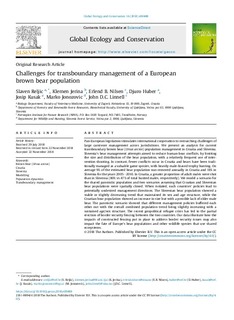| dc.contributor.author | Reljic, Slaven | |
| dc.contributor.author | Jerina, Klemen | |
| dc.contributor.author | Nilsen, Erlend B. | |
| dc.contributor.author | Huber, Djuro | |
| dc.contributor.author | Kusak, Josip | |
| dc.contributor.author | Jonozovic, Marko | |
| dc.contributor.author | Linnell, John D.C. | |
| dc.coverage.spatial | Croatia, Slovenia | nb_NO |
| dc.date.accessioned | 2019-01-07T14:06:30Z | |
| dc.date.available | 2019-01-07T14:06:30Z | |
| dc.date.issued | 2018 | |
| dc.identifier.issn | 2351-9894 | |
| dc.identifier.uri | http://hdl.handle.net/11250/2579516 | |
| dc.description.abstract | Pan-European legislation stimulates international cooperation to overarching challenges of
large carnivore management across jurisdictions. We present an analysis for current
transboundary brown bear (Ursus arctos) population management in Croatia and Slovenia.
Slovenia's bear management attempts aimed to reduce human-bear conflicts, by limiting
the size and distribution of the bear population, with a relatively frequent use of intervention
shooting. In contrast, fewer conflicts occur in Croatia and bears have been traditionally
managed as a valuable game species, with heavily male-biased trophy hunting. On
average 9% of the estimated bear population was removed annually in Croatia and 18% in
Slovenia for the years 2005e2010. In Croatia, a greater proportion of adult males were shot
than in Slovenia (80% vs 47% of total hunted males, respectively). We model a scenario for
the shared panmictic population and two scenarios assuming that Croatian and Slovenian
bear populations were spatially closed. When isolated, each countries' policies lead to
potentially undesired management directions. The Slovenian bear population showed a
stable or slightly decreasing trend that maintained its sex and age structure, while the
Croatian bear population showed an increase in size but with a possible lack of older male
bear. The panmictic scenario showed that different management policies buffered each
other out with the overall combined population trend being slightly increasing with a
sustained age/sex structure. The recent geopolitical refugee crisis has led to the partial
erection of border security fencing between the two countries. Our data illustrate how the
impacts of constructed fencing put in place to address border security issues may also
impact the fate of Europe's bear populations and other wildlife species that use shared
ecosystems | nb_NO |
| dc.language.iso | eng | nb_NO |
| dc.rights | Navngivelse 4.0 Internasjonal | * |
| dc.rights.uri | http://creativecommons.org/licenses/by/4.0/deed.no | * |
| dc.subject | brown bear | nb_NO |
| dc.subject | Ursus arctos | nb_NO |
| dc.subject | Modelling | nb_NO |
| dc.subject | Population dynamics | nb_NO |
| dc.subject | Transboundary management | nb_NO |
| dc.title | Challenges for transboundary management of a European | nb_NO |
| dc.type | Peer reviewed | nb_NO |
| dc.type | Journal article | |
| dc.rights.holder | © 2018 The Authors. | nb_NO |
| dc.subject.nsi | VDP::Matematikk og Naturvitenskap: 400::Zoologiske og botaniske fag: 480 | nb_NO |
| dc.source.volume | 16 | nb_NO |
| dc.source.journal | Global Ecology and Conservation | nb_NO |
| dc.identifier.doi | 10.1016/j.gecco.2018.e00488 | |

